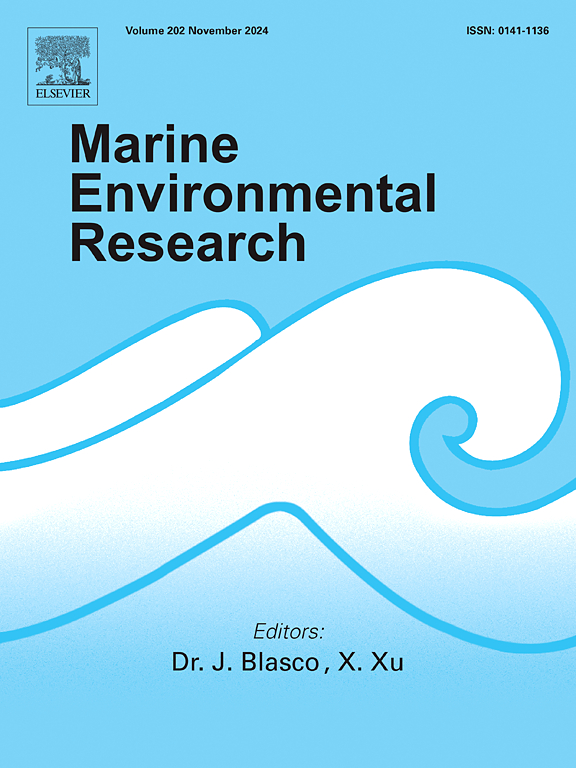Heavy metal dynamics in riverine mangrove systems: A case study on content, migration, and enrichment in surface sediments, pore water, and plants in Zhanjiang, China
IF 3
3区 环境科学与生态学
Q2 ENVIRONMENTAL SCIENCES
引用次数: 0
Abstract
Mangroves serve a crucial role as metal accumulators in tropical and subtropical marine ecosystems, particularly in riverine mangroves, which frequently interact with terrestrial sources. In this study, we focused on the Gaoqiao and Jiuzhou Rivers within the Zhanjiang mangrove forest in Guangdong, China, and collected leaves and surface sediments from the dominant mangrove plant, Aegiceras corniculatum, near the riverbanks. We focused on seven heavy metals (Cr, Cu, Zn, As, Cd, Pb, and Hg) in mangrove leaves, surface sediments, and pore water due to their environmental significance and frequent occurrence in mangrove ecosystems. We employed multivariate statistical methods and pollution indicators to assess the potential sources and risk levels of heavy metals in these sediments. Our results reveal that the concentrations of the seven heavy metals in the sediments of the Gaoqiao and Jiuzhou Rivers varied significantly, ranging from 0.03 mg/kg to 100.00 mg/kg. Cd posed the highest ecological risk, followed by Hg and As. The comprehensive potential ecological risk in the Gaoqiao River was lower than that in the Jiuzhou River, likely due to the distribution of industrial enterprises (such as printing and cement plants) in the upper reaches of the Jiuzhou River. Additionally, the heavy metal content in the leaves of A. corniculatum and in pore water within surface sediments ranged from 0.01 to 51.58 mg/kg and 0.001 to 133.70 μg/L, respectively. A significant correlation was observed between the heavy metal concentrations in the A. corniculatum leaves and those in the pore water. Notably, the leaves of A. corniculatum exhibited a remarkable Hg-enrichment capability, highlighting its potential as a mercury accumulator. Most heavy metals in A. corniculatum leaves, pore water, and sediment were concentrated in the middle and upper reaches of the river, primarily due to anthropogenic terrestrial inputs from residential production activities upstream. Consequently, heavy metal pollution in riverine mangroves is primarily associated with human activities such as aquaculture, agricultural planting, and industrial production.
河流红树林系统中的重金属动态:中国湛江表层沉积物、孔隙水和植物中重金属含量、迁移和富集的案例研究。
红树林在热带和亚热带海洋生态系统中发挥着重要的金属积累作用,尤其是在经常与陆地污染源发生相互作用的河流红树林中。在这项研究中,我们以中国广东湛江红树林内的高桥河和九洲河为重点,采集了河岸附近主要红树植物 Aegiceras corniculatum 的叶片和表层沉积物。我们重点研究了红树林叶片、表层沉积物和孔隙水中的七种重金属(铬、铜、锌、砷、镉、铅和汞)。我们采用多元统计方法和污染指标来评估这些沉积物中重金属的潜在来源和风险水平。结果表明,高桥河和九洲江沉积物中七种重金属的浓度变化很大,从 0.03 mg/kg 到 100.00 mg/kg。镉的生态风险最高,其次是汞和砷。高桥河的综合潜在生态风险低于九洲江,这可能是由于九洲江上游分布着工业企业(如印刷厂和水泥厂)。此外,草履虫叶片和表层沉积物孔隙水中的重金属含量分别为 0.01 至 51.58 mg/kg 和 0.001 至 133.70 μg/L。A. corniculatum 叶子中的重金属浓度与孔隙水中的重金属浓度之间存在明显的相关性。值得注意的是,A. corniculatum 的叶片表现出显著的汞富集能力,突出了其作为汞蓄积器的潜力。鸡冠花叶片、孔隙水和沉积物中的大部分重金属都集中在河流的中上游,这主要是由于上游居民生产活动造成的人为陆地输入。因此,河流红树林的重金属污染主要与水产养殖、农业种植和工业生产等人类活动有关。
本文章由计算机程序翻译,如有差异,请以英文原文为准。
求助全文
约1分钟内获得全文
求助全文
来源期刊

Marine environmental research
环境科学-毒理学
CiteScore
5.90
自引率
3.00%
发文量
217
审稿时长
46 days
期刊介绍:
Marine Environmental Research publishes original research papers on chemical, physical, and biological interactions in the oceans and coastal waters. The journal serves as a forum for new information on biology, chemistry, and toxicology and syntheses that advance understanding of marine environmental processes.
Submission of multidisciplinary studies is encouraged. Studies that utilize experimental approaches to clarify the roles of anthropogenic and natural causes of changes in marine ecosystems are especially welcome, as are those studies that represent new developments of a theoretical or conceptual aspect of marine science. All papers published in this journal are reviewed by qualified peers prior to acceptance and publication. Examples of topics considered to be appropriate for the journal include, but are not limited to, the following:
– The extent, persistence, and consequences of change and the recovery from such change in natural marine systems
– The biochemical, physiological, and ecological consequences of contaminants to marine organisms and ecosystems
– The biogeochemistry of naturally occurring and anthropogenic substances
– Models that describe and predict the above processes
– Monitoring studies, to the extent that their results provide new information on functional processes
– Methodological papers describing improved quantitative techniques for the marine sciences.
 求助内容:
求助内容: 应助结果提醒方式:
应助结果提醒方式:


